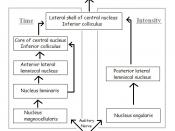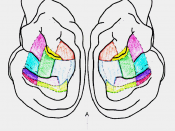Abstract
The purpose of this study was to determine the relationship between the pinnae and sound localisation along the mid-line. Four hundred and eleven participants were tested in normal and distorted conditions at various positions on the mid-line. Each participant was tested for sound localisation in three positions using the same sound source, a set of car keys. The hypothesis that the pinnae play an important role in sound localisation along the mid-line is clearly supported.
Sound localization is as important as the ability to perceive sound itself. Most humans are not aware or tend to ignore the ability to locate a particular sound source in space. The understanding of how to locate a sound source is an integral part of enhancing normal hearing and the hearing impaired population.
The key to locating sounds is in fact having two ears roughly six inches apart on opposite sides of the head.
When sound comes from our right, it has less distance to travel to reach the right ear than the left ear. The interaural time differences (ITD) may be very small but is enough for us to sense and process. Another way human's process location is by comparing interaural intensity difference (IID). The farther ear receives a sound of less intensity than the closer ear because our heads absorb some of the sound going to the farther ear. It seems that the ITD method is better for low frequency sounds and the IID method is better for high frequency sounds. If a sound comes from a source equidistant from our ears (mid-line), arriving at both ears simultaneously, humans are easily confused, with this, we draw on one of our hypotheses 'that sound localisation is possible in the midline'.
A previous study data obtained by positioning a sound source (firstly,


